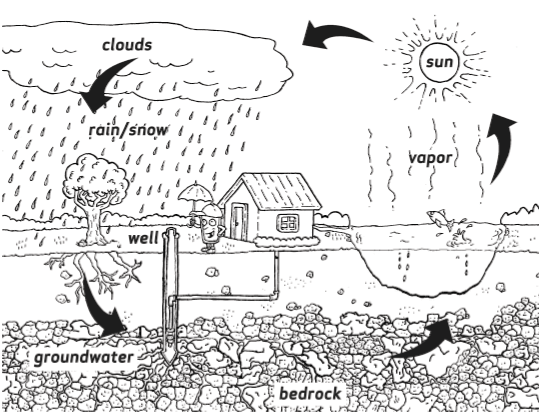Here is some information from Weather Wiz Kids,
which is a fabulous website developed by Crystal Wicker, a
meteorologist, who wanted to provide kids with a way to learn more about
the fascinating world of weather.
What is the Water Cycle?
Earth has a limited
amount of water. So, that water keeps going around. We call it the water cycle.
The water cycle begins with evaporation. Evaporation is when the sun heats up
water in rivers, lakes or the ocean. Then turns it into water vapor or steam.
The water vapor or steam leaves the body of water and goes into the air.
Transpiration is the process by which plants lose water out of their leaves.
Condensation is when water vapor in the air gets cold and changes back into
water to form clouds. Think of it this way, when you open a cold soda on a hot
summer day, your soda will start to sweat as water droplets form on the outside
of the can. Precipitation occurs when so much water has condensed that the air
can't hold it anymore. This is how we get rain or snow. Collection happens when
the precipitation falls and is collected back in the oceans, lakes and rivers.
When it falls to the ground, it will soak into the earth and become ground
water. This is the water cycle and it just keeps repeating.
The class did an experiment that really helped the kids visualize the concepts of evaporation, condensation and precipitation. What's also cool about this experiment (and the teachers in the class) is that it accidentally helped the kids understand how molecules move around more in hot water. I say accidentally, because the water wasn't hot enough the first time they attempted the experiment, so it didn't work. The teacher didn't miss a beat (I tend to panic when the experiments don't go as planned!), she just went on to explain the science behind the molecules moving around in the water and that they weren't moving around enough - because the water wasn't hot enough - so they weren't separating off into steam. After they got the really hot boiling water, the experiment worked as planned, and the kids got to see the steam rising and mixing with the ice cold air at the top of the jar and actually forming a little cloud and then droplets of rain. You had to look really closely, but the kids thought it was great.
 | |
| photo from icanteachmychild.com |
My favorite part about this was watching the expectant looks on all the faces of the students. I love that they are so eager to see new things and learn about the why and the how behind how it works too.
~~Vicki~~


No comments:
Post a Comment